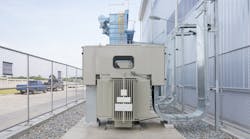Many people mistake this to mean that a transformer with 10% regulation will keep the output voltage to a value within 10% of nominal. That's simply not so. Let's take a look at what transformer voltage regulation is, and why it's useful to you.
In any step-down transformer, the secondary current produces a voltage drop across the resistive and reactive components of the transformer's secondary side. On the other side, the primary current produces voltage drops across the resistive and reactive components of the transformer's primary side. From this, it's easy to see the primary voltage will be less than the supply voltage, and the secondary (output) will be less than either of those.
Let's assume you have no load connected to your transformer. In such a case, no secondary current flows. With no current, you have no voltage drop across those resistive and reactive components of the transformer's secondary side. But, another thing happens. Without a secondary current, the primary current drops to the no-load current—which is nearly zero. This means the voltage drop across the resistive and reactive components of the transformer's primary side becomes very small. What's the net effect? In a no-load situation, the voltage on the primary is almost equal to the supply voltage, and the secondary voltage nearly equals the supply voltage times the ratio of primary windings to secondary windings.
You might assume the transformer's output voltage is highest at no load. It would then make sense that (under loaded conditions) the transformer's resistive and reactive components cause the output voltage to drop below its no-load level. This is a logical assumption, but one that's not necessarily so. Depending on the power factor of the load, the output full-load voltage may actually be larger than the no-load voltage.
| This related article explains why a nominal voltage must be standardized to troubleshoot long-duration voltage variations. Understanding Voltage Fluctuations and Steady-State |
The voltage regulation of the transformer is the percentage change in the output voltage from no-load to full-load. And since power factor is a determining factor in the secondary voltage, power factor influences voltage regulation. This means the voltage regulation of a transformer is a dynamic, load-dependent number. The numbers you see in the nameplate data are fixed; the number of primary windings won't change; the number of secondary windings won't change, etc. But, the voltage regulation will vary as power factor varies.
Ideally, there should be no change in the transformer's output voltage from no-load to full-load. In such a case, we say the voltage regulation is 0%. To get the best performance out of your transformer, you need the lowest possible voltage regulation. You should calculate the voltage regulation and save the result as a troubleshooting and predictive maintenance benchmark. Suppose the percentage change is too high. What do you do? You now know you need to look at power factor correction for the loads on that transformer. A power factor meter can be very helpful in this case.




